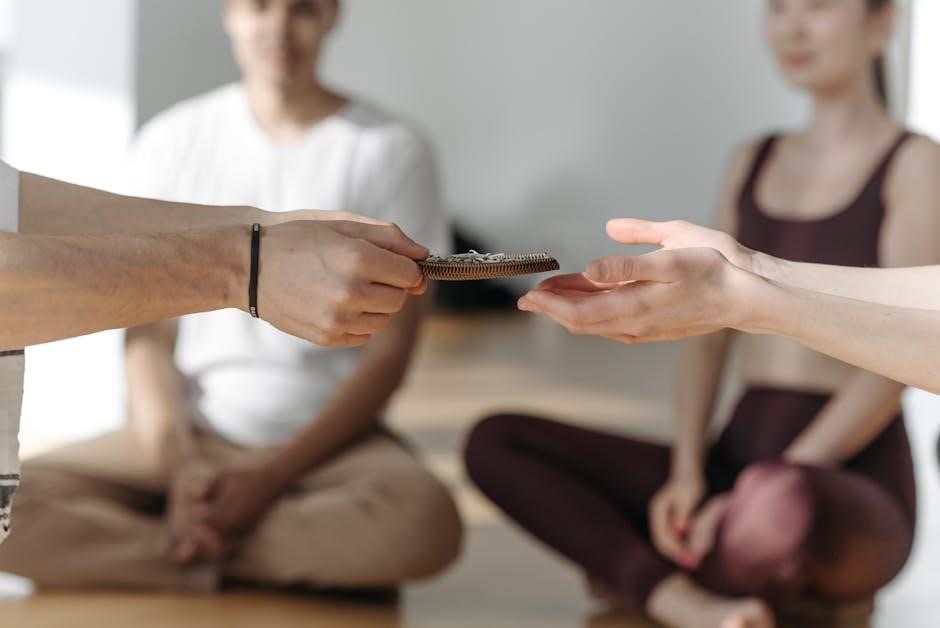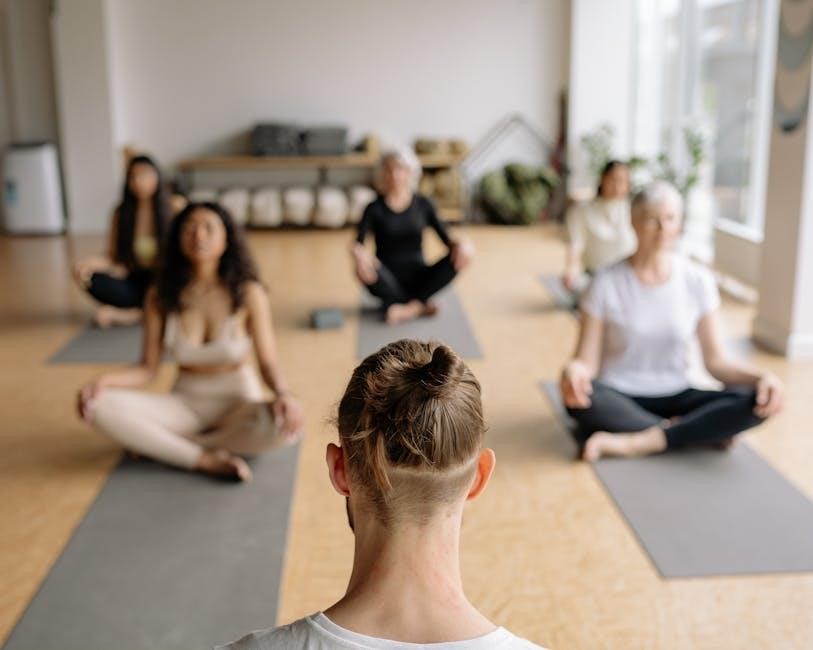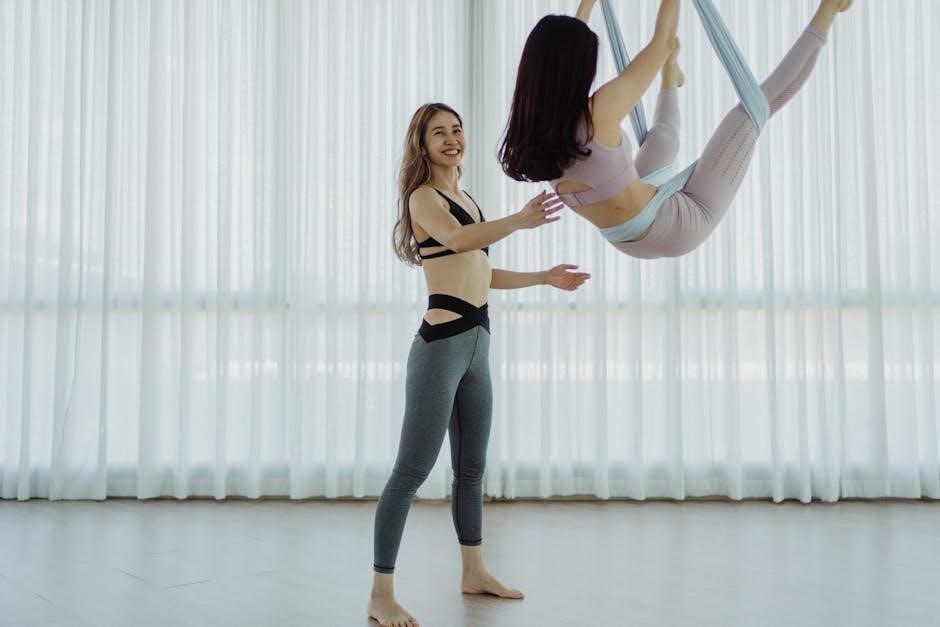Guided meditation is a mindfulness practice where visualization and breathing techniques help reduce stress‚ improve focus‚ and promote inner peace through structured sessions led by an expert.

Preparing the Environment
Creating a serene atmosphere is essential for guided meditation. Choose a quiet‚ comfortable space with minimal distractions and soft lighting to promote relaxation.
Setting Up the Physical Space
Setting up the physical space is crucial for creating a conducive environment for guided meditation. Choose a quiet‚ comfortable‚ and clutter-free area where participants can sit or lie down. Ensure the room is well-ventilated and at a comfortable temperature. Consider using cushions‚ blankets‚ or chairs to support relaxation. Soft lighting can create a calming ambiance‚ while neutral colors on walls can enhance focus. Minimize noise by closing windows or using white noise machines if necessary. Remove distractions like electronic devices or sharp objects. Optional elements include calming scents from essential oils or soft instrumental music played at a low volume; These details collectively help participants relax and focus‚ making the meditation session more effective.
Minimizing Distractions
To create an optimal meditation environment‚ it’s essential to minimize distractions. Begin by asking participants to turn off their electronic devices or set them to silent mode. Explain the importance of minimizing interruptions during the session to ensure everyone’s focus. Use a timer to avoid clock-watching and maintain a consistent session length. Consider using white noise machines or soft instrumental music to mask any background sounds. If leading meditation in a shared space‚ communicate with others to avoid disruptions. Encourage participants to find a comfortable position and close their eyes to reduce visual distractions. These steps help create a serene atmosphere‚ allowing participants to fully immerse in the meditation experience without interruptions.

Setting the Intention
Setting the intention defines the purpose of the meditation‚ guiding participants toward specific outcomes like stress reduction or emotional clarity‚ enhancing focus and mindfulness throughout the session.
Creating a Clear Intention for the Session
Creating a clear intention for the session involves defining a specific goal or focus‚ such as stress reduction or emotional clarity‚ to guide participants effectively. This intention should be communicated at the beginning to align everyone’s mindset and ensure a cohesive experience. It helps participants stay focused and directed‚ allowing them to fully engage with the meditation. The intention also influences the structure of the session‚ including the duration‚ techniques‚ and visualization used. By setting a clear intention‚ you provide a roadmap for the meditation‚ ensuring it remains meaningful and purposeful. This clarity also allows participants to connect deeply with the practice‚ fostering a sense of calm and inner awareness.

Leading the Meditation Session
Leading a meditation session involves guiding participants with a calm tone‚ clear instructions‚ and a structured flow‚ incorporating visualization and breathing techniques to foster relaxation and mindfulness.
Using Visualization Techniques
Visualization techniques are a powerful tool in guided meditation‚ helping participants create vivid mental images to evoke emotions and relaxation. Guides should describe scenes in detail‚ encouraging the use of all senses to immerse participants in the experience. For example‚ visualizing a serene beach might involve describing the sound of waves‚ the warmth of the sun‚ and the texture of sand. This practice helps participants disconnect from stress and reconnect with their inner selves‚ fostering a deeper state of calm and awareness. Effective visualization guides participants through a journey that enhances mindfulness and emotional well-being‚ making it a cornerstone of guided meditation sessions.
Incorporating Breathing Exercises
Breathing exercises are fundamental in guided meditation‚ helping participants relax and focus. Guides should introduce techniques like the “4-7-8” method or box breathing to promote calmness. Begin by instructing deep inhales through the nose‚ filling the lungs completely‚ followed by a brief hold‚ and a slow exhale through the mouth. This rhythm helps quiet the mind and reduce stress. Encourage participants to focus solely on their breath‚ letting go of distractions. Breathing exercises can be adapted to the session’s purpose‚ whether for stress relief or improving concentration. Regular practice enhances emotional balance and overall well-being‚ making breathing a cornerstone of effective guided meditation sessions.
Handling Distractions During Meditation
Distractions are natural during meditation. Acknowledge them gently and guide participants back to their breath or visualization‚ ensuring a calm and focused environment for deeper mindfulness.
Strategies to Refocus Participants
When distractions arise‚ gently guide participants back to the present moment using calm‚ reassuring tones. Encourage them to acknowledge the distraction without judgment and refocus on their breath or visualization. Use grounding techniques‚ such as body scans or mindful breathing exercises‚ to anchor their attention. Incorporate positive affirmations to reinforce a sense of calm and control. If needed‚ pause the session briefly to offer a moment of silence or a brief stretch. Remind participants that it’s natural for the mind to wander and that refocusing is part of the practice. This empathetic approach helps participants feel supported and encourages them to stay engaged‚ fostering a deeper meditative experience.

Ending the Meditation
Conclude by guiding participants to slowly open their eyes‚ emphasizing deep breaths and a gradual return to awareness‚ ensuring a gentle transition back to the present moment.
Bringing Participants Back to Awareness Gently
As the session nears its end‚ guide participants to gradually return to awareness by suggesting they take slow‚ deep breaths‚ noticing sensations in their body‚ and becoming mindful of their surroundings. Speak calmly‚ encouraging them to acknowledge their presence in the room without rushing. Remind them to carry the sense of calm and clarity into their day. Gentle transitions help participants reintegrate smoothly‚ ensuring the meditation’s benefits linger. This mindful approach fosters a sense of continuity between the meditative state and daily life‚ enhancing overall well-being.
Connecting with Participants
Building a genuine connection involves active listening‚ empathy‚ and presence‚ fostering trust and creating a safe environment for participants to explore their inner experiences during meditation.
Being Present and Empathetic
Being present and empathetic is crucial for creating a supportive environment during guided meditation. Leaders must fully engage with participants‚ understanding their emotions and experiences without judgment. Empathy fosters trust‚ allowing individuals to feel safe and understood. Active listening and non-verbal cues‚ such as gentle nods or calm gestures‚ reinforce this connection. By remaining fully attentive and compassionate‚ leaders can tailor their guidance to meet the unique needs of the group. This presence not only enhances the meditation experience but also deepens participants’ feelings of comfort and security‚ making the session more meaningful and transformative for everyone involved;

Cultural Sensitivity in Meditation
Cultural sensitivity in meditation requires creating an inclusive environment that respects diverse traditions‚ ensuring all participants feel comfortable and valued in their practice.
Respecting Different Cultural and Spiritual Traditions
Respecting diverse cultural and spiritual traditions in meditation involves acknowledging and honoring participants’ backgrounds. This can be achieved by incorporating universal themes and avoiding practices tied to specific religions or cultures without context. Leaders should educate themselves about various traditions and avoid cultural appropriation. For instance‚ using mantras or prayers respectfully‚ with permission or clear attribution‚ fosters inclusivity. Creating a safe space where participants feel comfortable sharing their traditions can enhance the experience. Encouraging mindfulness of cultural differences while promoting unity helps build a harmonious environment. By being sensitive and open‚ leaders ensure that meditation remains accessible and respectful to all‚ regardless of their cultural or spiritual beliefs.

Encouraging Consistency
Consistency in meditation practice fosters deeper mindfulness and lasting benefits. Encourage participants to set realistic goals‚ celebrate progress‚ and establish a regular routine for sustained growth and well-being.
Motivating Participants to Practice Daily
Motivating participants to practice daily is crucial for building a consistent meditation habit. Encourage them by highlighting the benefits of regular practice‚ such as reduced stress and improved focus. Provide simple‚ accessible techniques that fit into their busy schedules. Share success stories or testimonials to inspire commitment. Offer reminders or guided sessions to keep them engaged. Celebrate small milestones‚ like completing a week of daily meditation‚ to reinforce progress. Make the practice enjoyable by incorporating variety and ensuring it feels achievable. Remind them that even a few minutes each day can make a significant difference in their well-being. Consistency is key to experiencing lasting benefits.
